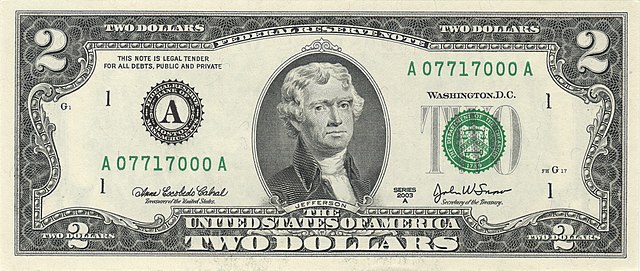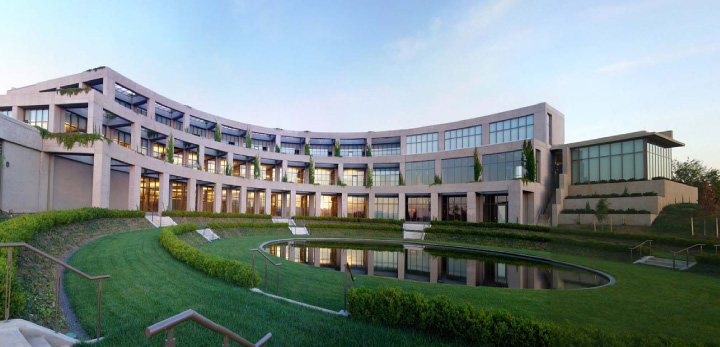Why The Government Hid Billion of Dollars Worth of $2 Bills

If you’re in the United States right now, and you have some cash in your wallet, chances are they come in one of six denominations: $1, $5, $10, $20, $50, or $100. But there’s another denomination available if you’re so inclined, as seen above — the $2 bill. Often believed to be only collectors’ items, these bills are legal tender and not rare at all; in most places, you can go to your local bank and, if you hand them a $20 and ask for ten $2s back, they’ll gladly oblige. Similarly, any store that accepts cash is supposed to accept $2 bills as well (although there have been plenty of stories of clerks rejecting such currency thinking the bills are fake).
In any event, though, $2 bills are rarely seen in normal, everyday use. And, importantly for our purposes today, they’re also unpopular. That’s why the place pictured below used to have a billion or so of them stored within its walls.

That building, today, is the main campus of the National Audio-Visual Conservation Center, an institution run by the Library of Congress and situated in Culpepper, Virginia. (Here’s a map.) The photo, the easily-Googled map location, and the manicured landscape should all make it clear that the building’s existence isn’t a closely-held government secret, nor is it a high-security location. And nor should it be. Today, the site is used to house more than six million movies, television shows, songs, and other sounds in the Library’s collection. It is open to the public and there’s even a 200+ person screening room, which, according to the Center’s official website, “features an organ rising from under the stage to accompany silent film screenings.”
But if you tried to visit the same site in the 1970s and into the 1980s, you would have been met with a different experience. You wouldn’t have seen a new building with a movie theater and organ; all you would have seen were barbed wire fences before you were turned away (if not arrested). From 1969 until 1988, the location was off-limits to visitors, and for good reason. The site, then known as Mount Pony, was home to billions of dollars in uncirculated American currency.
The late 1960s were a precarious time for the United States and the world. The Cold War — a standoff primarily between the U.S. and the Soviet Union, the two largest nuclear powers at the time — meant the threat of thermonuclear war was always present. And if that were to happen, the loss of life and destruction to infrastructure would be astronomical. That said, there would still be survivors, and those survivors would be inheriting a world that needed rebuilding. The American government (and presumably the Soviet one, too, but that’s another story) put into place a lot of contingency plans in case of such devastation, and as Wired notes, “as previous experience showed, hard cash is vital for any rebuilding plans.” Therefore, the government came up with a way to replenish the money supply in case billions of dollars were vaporized in a moment.
Mount Pony was central to that plan. Described by the Federation of American Scientists as “a 400-foot long bunker is built of steel-reinforced concrete a foot thick,” the facility featured “lead-lined shutters can be dropped to cover the windows of the semi-recessed facility, which is covered by 2 to 4 feet of dirt and surrounded by barbed-wire fences and guard posts.” It was designed to protect its contents from a nuclear strike (and, via the fences and guards, from more conventional assaults), and those contents were cash. How much money Mount Pony had on hand is unclear — estimates range as low as $2 billion and to as much as $5 billion — but according to the book “Cold War Secret Nuclear Bunkers,” there was enough money in the building to replenish the entire supply of cash east of the Mississippi if need be.
Thankfully, that money never needed to be distributed. But had nuclear war necessitated opening up Mount Pony’s vaults, the currency of the United States would look very different than it does today. Instead of using one- and five-dollar bills, the survivors would be given $2 bills instead. WBUR explains:
A large portion of that money was hidden away in $2 bills because in the 1970s when the government first introduced the $2 bill and discovered that Americans didn’t want to use them, they didn’t want to pulp and waste the money. So they just shrink-wrapped all the $2 bills and hid them away in a government bunker, figuring that after nuclear war, people wouldn’t have that much of a choice about what type of currency they wanted to use anymore.
When Mount Pony was decommissioned as a Federal Reserve storehouse, the $2 bills were taken out — but it’s not clear where they went. Maybe they were pulped after all, or maybe they are collecting dust somewhere in case we need to rebuild from a different mass catastrophe. Hopefully, we’ll never have to find out.
Bonus fact: Had the U.S. been involved in a nuclear war, the Supreme Court’s members would have fled to the Grove Park Inn, a hotel in North Carolina — maybe. In the 1950s, the Court agreed to use the facility — a resort with pools and a golf course — as its venue if Washington, D.C., were attacked. But, according to Atlas Obscura, “security upgrades were never made at Grove Park,” most likely because Chief Justice Earl Warren didn’t care to bother with the issue. Per Atlas Obscura, “Warren harbored no illusions about his prospects for survival in a nuclear attack and viewed continuity of government as a joke. Throughout the Cold War, Supreme Court Justices regularly skipped the drills evacuating federal employees from Washington.” And there was another complication as well — Warren, according to History.com, didn’t want to go there even if he had survived: “Warren said he would never leave Washington, D.C., after learning wives would not be allowed to evacuate with their husbands.”
From the Archives: Thermonuclear War and Taxes: America has a plan in place to make sure you keep paying your taxes in case you survive a nuclear war.
